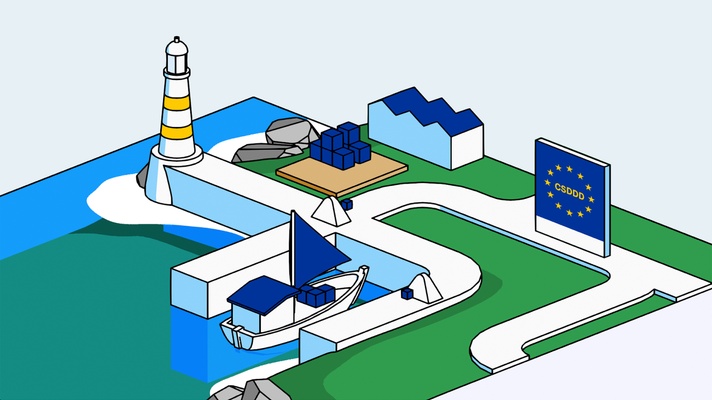What is Bilan Carbone?


- Author
- Bryony CollinsClimate Writer
- Category
- Climate Essentials
- Topics
- RegulationsCarbon
- Published
- 23 February 2023
Contents
- Which companies does it cover?
- What are the Bilan Carbone requirements?
- Which emission scopes are covered by Bilan Carbone?
- Which GHG emissions does it cover?
- How can you start measuring your carbon footprint using Bilan Carbone?
- What are the next steps in drawing up an emissions action plan?
- How can you prepare for the future?
- How can you deliver a Bilan Carbone report?
- How can Sweep help you report your emissions using Bilan Carbone?
The Bilan Carbone method was developed in 2011 by the French Environment and Energy Management Agency, ADEME, to help companies quantify their greenhouse gas emissions and develop an action plan to start reducing them. It is promoted by the Association Bilan Carbone (ABC).
Which companies does it cover?
The Bilan Carbone requirements apply to the following organizations in France since the Grenelle II law of July 2010:
- Companies with over 500 employees in France and/or over 250 employees in French overseas departments
- Communities of more than 50,000 individuals
- Public bodies and state agencies with over 250 employees
These organizations are required by law to undertake a greenhouse gas emissions assessment every 4 years. The Bilan Carbone must be published on a dedicated platform managed by the organization, with failure to comply resulting in a fine of up to €1,500.
Voluntary participation for companies not meeting the requirements is also highly valued by investors, customers and the government.
What are the Bilan Carbone requirements?
The methodology requires that reporting companies do the following:
- Enter complete data covering the broadest possible range of relevant emissions.
- Consider the emissions categories relevant to your organization.
- Provide transparent information for clear decision making.
- Ensure that the results of your inventory are verifiable.
Which emission scopes are covered by Bilan Carbone?
Your Bilan Carbone inventory must cover all direct emissions and indirect emissions related to your company activity. This includes energy consumed in production or operations, transport of freight, customers or employees and end-of-life treatment of the products sold.
Which GHG emissions does it cover?
Bilan Carbone covers all of the Kyoto Protocol gasses: carbon dioxide (CO2), methane (CH4), nitrogen oxide (N20), SF6 hydrofluorocarbons (CnHmFp), perfluorocarbons (CnF2n+2), and nitrogen trifluoride (NF3). In addition to all other non-Kyoto Protocol gasses (CFCs) and any water vapor emitted by planes at the stratospheric level.
How can you start measuring your carbon footprint using Bilan Carbone?
Your company should follow these steps when measuring and reporting its emissions footprint using the Bilan Carbone method:
Choose a project manager to lead the Bilan Carbone process, supported by executive management. If you decide to use an external consultancy instead, choose one specialized in using the Bilan Carbone method.
Decide on how often your company will conduct its emissions inventory. Annual reporting is encouraged, but you can choose another timeframe if you wish.
Map out all the streams of energy and materials that your company uses to carry out its operations including energy, raw materials, transport, finished products and waste. Draw up a flow chart of this activity data.
Quantify your company’s emissions by converting your activity data into CO2 equivalent units using this formula:
Greenhouse gas emissions = activity data x corresponding emissions factor
5. Group your company’s emissions by category in order to identify the most polluting areas. Direct your efforts there first.
6. Draw up an emissions reduction action plan as summarized below.
7. Deliver your Bilan Carbone inventory report on a dedicated platform managed by your company.
8. Agree regular activity review dates and update your Bilan Carbone inventory.
What are the next steps in drawing up an emissions action plan?
Bilan Carbone recommends setting up technical committees in your company to draw up action plans to reduce your company's carbon footprint. It is useful to identify high-priority areas where you can reduce emissions fast and short-term actions you can take to motivate staff.
Be sure to set objectives for your emissions reduction and to regularly monitor progress on those objectives.
How can you prepare for the future?
Consider developing a low-carbon transition plan for your organization to assess how your business activity may evolve in line with increasingly stringent environmental and energy regulations.
Continue to monitor your activity data so that your next Bilan Carbone inventory delivers an accurate emissions footprint. Strive to set up a process for periodic collection of GHG emissions from activity data so that collection is fast and efficient.
How can you deliver a Bilan Carbone report?
Your chosen project manager should prepare and draft your company's Bilan Carbone report with the participation of all in-company stakeholders.
In general, your report should include the following:
- Description of the organization.
- Input/output flow charts of company activity.
- Time frame of the inventory.
- Documentation of the organizational boundaries and a justification/explanation for them.
- The GHG profile of your company, including emissions in CO2 equivalent.
- Description of emission factors used.
- Action plan and recommendations for reducing the carbon footprint.
- Indicators for how to monitor successful progress.
- A low-carbon transition vision for the organization.
How can Sweep help you report your emissions using Bilan Carbone?
Sweep helps you track your carbon footprint across your entire value chain, helping you to comply with the latest legislation, including Bilan Carbone.
Find out more here.
More stories
Track, report and act
Sweep helps you get your carbon on-track
Sign up to The Cleanup, our monthly climate newsletter


© Sweep 2024


